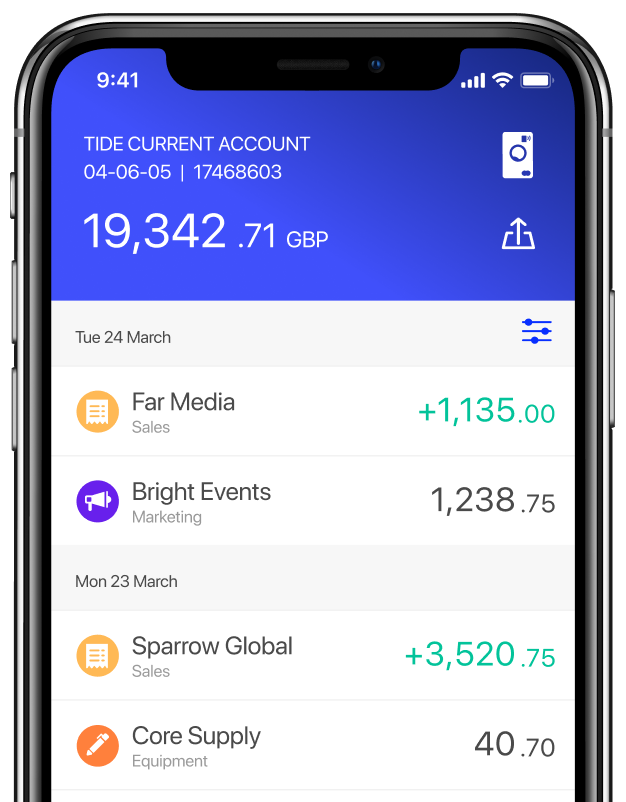
Grow your business with Profitability Insights

As a business in a challenging economic landscape, being data-driven is more important than ever. Here at Tide, we prioritise giving our members access to the right insights at the right time, to help you maximise your profit margins, identify opportunities for expense management and set yourself realistic growth goals.
Our embedded accounting tool, Tide Accounting, helps small business owners by combining their banking and accounting in one place. From helping with filing tax returns, to tracking business performance and simplifying bookkeeping, Tide Accounting and Tide Accounting Extra do the work for you.
Let’s take a look at how Tide Accounting’s smart features, particularly the Extra plan’s Profitability Insights, can help you understand your business growth metrics and make data-driven decisions quickly
Table of contents:
- Revenue
- Expenses
- Net Profit
- Decoding your profitability insights
- Final thoughts
Revenue
Your revenue is the gross amount of money you earn from selling products or services. It’s the total amount of income a business has earned before subtracting any expenses.
To get an accurate view of your revenue, it’s important to keep your bookkeeping up to date. Tide Accounting provides you with a range of smart bookkeeping tools to help you categorise your transactions quickly, so you can easily distinguish between your income and expenses.
Expenses
Your expenses are the cash that your business spends on creating the products you sell, including marketing and any administrative tasks.
To make expense tracking easier than ever, Tide Accounting connects to your Tide bank account. Any payments you make will automatically be pulled through to Tide Accounting, so you can manage everything in one place.
Net profit
Your net profit, also known as net revenue or net income, shows what’s left over after you’ve subtracted all your operating expenses and cost of sales from your revenue. This makes up your true profitability.
It’s calculated by subtracting your expenses from your revenue – net profit is one of the most important metrics for your business, and is considered a key indicator of business health.

Decoding your Profitability Insights with Accounting Extra
Understanding your profitability insights can seem a bit daunting when you first start, so here are a few things to keep in mind to make it easier to navigate.
- The Profitability Insights graph shows you your net profit, revenue and expenses by month. To make sure this graph is accurate, you’ll need to complete all your bookkeeping tasks.
- If you have multiple business bank accounts, make sure to link them to Accounting Extra so you can get a full picture of your finances. If you have stand-alone transactions (eg. a credit card payment), you should add that manually as a new transaction record.
- Check your profit every month to see if it’s increased or decreased. If your profit is increasing, this is usually a good sign – but in some cases, decreasing profits are to be expected, for example if your business is impacted by seasonality.
- It’s important to understand why your net profit has changed so you can make informed decisions about your strategy in the coming months.
| Changes in profitability: | Things you can do: |
| Net profit can increase because you’re selling more and your revenue has gone up. | This is great news – well done! Growing your business is no easy feat. Dig into what’s driving this revenue growth and keep doing that – you’re onto something good! |
| Net profit can also increase because you’ve cut back on expenses and you’re spending less. | Being cost-efficient is usually a good defence strategy when revenue isn’t growing at a rate you’d expect. You might also find that even if your revenue is growing at a healthy pace, you have opportunities to reduce costs on things that you no longer need. For example, Accounting Extra helps you do your bookkeeping efficiently, so you may decide you only need accountant support for more technical areas. |
| Net profit can decrease if your sales drop because you’ll have less revenue. | Try to identify where the loss in revenue is coming from. This will help you understand how best to overcome this challenge and scale up your revenue again. Think of your customer list and any other sales channels you might be using. |
| Net profit can decrease if your expenses increase because you’re spending more. | Try to understand why you’ve been spending more and where the money has been going. Get a detailed breakdown of your expenses by downloading your Profit & Loss report, and look at how your spending trends have changed over the last few months to identify any increases. |
Wrapping up
Growing your business is a journey. There will be days where things go incredibly well, and others where they’re not so good. In both cases, Accounting Extra’s Insights will help answer some key questions about your business performance, so you can make informed decisions about your next steps.



